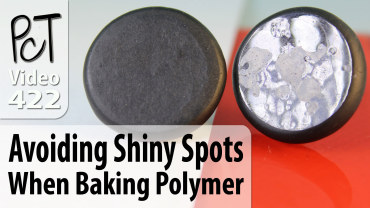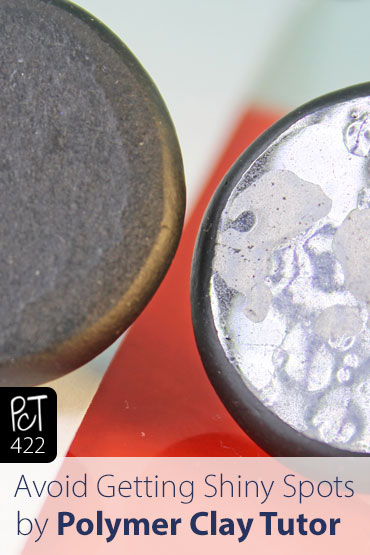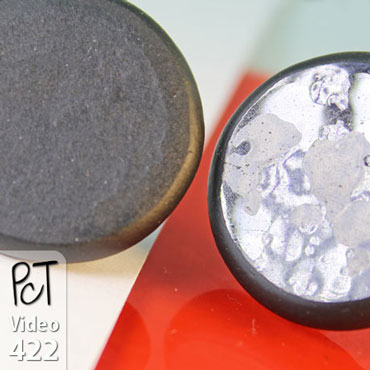Baking Beads So They Don’t End Up With Shiny Spots
Video #422: There’s a time when shiny is good… but there are also times when it looks really terrible!
More...
IN THIS POST: — shiny spots — baking — baking pans — glass tiles — ceramic tiles — parchment paper — card stock — (Topics marked with an asterisk* are discussed in the Comments Section below).
Topics Covered In This Video:
- I did a tips video several weeks ago about How to Remove Fingerprints and Shiny Spots Using Acetone, but since there were so many comments from people having problems with shiny spots, I thought I’d do a video on how to avoid them in the first place.
- Shiny spots on the back of your polymer clay pieces, happen when you bake on shiny surfaces. Whether it is a shiny glass or ceramic tile, a metal pan or a glass pie plate. If you stick your clay piece directly on a shiny surface while baking, it will leave a shiny spot on the back.
- I show two samples of polymer clay; One baked directly on a shiny glass tile, and one baked on a piece of paper sitting on top of the same tile. The piece that baked on the paper has a smooth, matte finish. And the one baked directly on the glass surface has a mottled, uneven surface with some very shiny spots. Needless to say, the one baked on the paper looks way better!
- You can bake any polymer clay piece on a piece of paper. Just lay a sheet or two of plain office paper (no printing) or a piece of cardstock or file folder on top of your baking pan or tile, and then add your polymer clay pieces.
- I used to use parchment paper (aka baking paper) to bake polymer clay on, but I found that some brands will wrinkle in the oven and some will leave shiny spots… so you might as well just use regular paper instead.
- Paper is fine in the oven at the low temperatures that we bake polymer clay at. VERY IMPORTANT: Make sure the paper does not touch the elements or the inside walls of your oven… or the paper could catch fire. But other than that, paper will be OK in the oven at low temperatures.
00:00:04 –> 00:00:08 Hi guys, its Cindy Lietz, your Polymer Clay Tutor, and today’s Studio Tip is avoiding
00:00:08 –> 00:00:11 shiny spots when baking Polymer Clay.
00:00:11 –> 00:00:17 Now I did a video just a little bit ago on how to remove fingerprints and shiny spots
00:00:17 –> 00:00:22 using acetone, but since there was a lot of comments on the shiny spots on the first place,
00:00:22 –> 00:00:26 I thought I’d show you how to avoid them, so that you don’t have to worry about removing
00:00:26 –> 00:00:27 them.
00:00:27 –> 00:00:35 So shiny spots on the back of your clay happen when you bake your piece on a shiny surface,
00:00:35 –> 00:00:43 whether it’s a glass tile like this tile I have here or a metal pan like this, or even
00:00:43 –> 00:00:47 a glass pie plate or something, if you just put your Polymer Clay straight onto a shiny
00:00:47 –> 00:00:53 surface and then bake it, it’s going to transfer to the back and leave it very shiny.
00:00:53 –> 00:00:58 Now I’ve got some samples here, this one I baked right on the shiny glass, and this one
00:00:58 –> 00:01:01 I baked on a piece of regular office paper.
00:01:01 –> 00:01:06 Now let me show you the difference between the way the two of them look on the back,
00:01:06 –> 00:01:08 isn’t that a big difference?
00:01:08 –> 00:01:13 This one’s smooth and matte looking, and this one’s shiny with all kinds of little
00:01:13 –> 00:01:18 flaws where the piece wasn’t sticking perfectly to the back.
00:01:18 –> 00:01:26 Now, you can bake any of your pieces on paper, just put a piece of paper between your surface…so
00:01:26 –> 00:01:31 if it’s your pan, you put a piece of paper in the bottom here, and with metal I like
00:01:31 –> 00:01:36 to double it up at least so that it gives a little more insulation, you can use regular
00:01:36 –> 00:01:43 paper or you can use like a piece of file folder or card stock, something like that
00:01:43 –> 00:01:48 works great, I also use it if I’m putting it on top of a tile or in any kind of pan.
00:01:48 –> 00:01:54 I also like to put it in the bottom of my bead rack, just like this, and then that way…I
00:01:54 –> 00:02:00 put a few sheets of paper in there, that way, if the…
00:02:00 –> 00:02:04 I’m baking some beads on the top, I can put some flat pieces in the bottom here and use
00:02:04 –> 00:02:08 up all that space under there while it’s baking at the same time, so that’s a great little
00:02:08 –> 00:02:09 tip.
00:02:09 –> 00:02:16 Now I used to use parchment paper but some of the brands a little bit… will go kinda
00:02:16 –> 00:02:21 wrinkly, and some brands will be a little bit shiny anyways, so you might as well just
00:02:21 –> 00:02:23 use the regular paper.
00:02:23 –> 00:02:29 And lastly, paper does fine in the oven at the temperature that we’re baking at, but
00:02:29 –> 00:02:34 you wanna make sure not to touch the elements with the paper, so make sure the paper isn’t
00:02:34 –> 00:02:38 coming up and touching the walls or the elements, or any of the burners or anything ‘cause
00:02:38 –> 00:02:44 otherwise it could catch on fire, but other than that, it’s just fine in the oven.
00:02:44 –> 00:02:48 So I hope that tip was helpful for you, if it was, make sure to click that like button
00:02:48 –> 00:02:50 that would be great.
00:02:50 –> 00:02:57 And my question for you today is, do you have trouble with shiny spots on your Polymer Clay?
00:02:57 –> 00:02:59 And do you think you’ll use this tip?
00:02:59 –> 00:03:03 Leave your answers in the comment section below, that would be great.
00:03:03 –> 00:03:08 And don’t forget to subscribe, we have new videos coming out every week and you’re not
00:03:08 –> 00:03:10 gonna wanna miss a thing.
00:03:10 –> 00:03:12 So we’ll see you next time and bye for now.
Our goal is to translate these videos into as many languages as possible. If you are interested in helping with this initiative, then please do contact us and we will figure out a way to make it worth your while :)
Resource Links:
- Related Video: Acetone For Removing Fingerprints From Polymer Clay
- Related Video: Using a Tile Sandwich for Baking Flat Polymer Clay
- Related Video: Most Common Polymer Baking Questions… Answered
- Related Video: Essential Polymer Clay Tools Oven Thermometer
- Related Video: Foil Pan Lids Will Protect Your Polymer Clay In The Oven
- Amazon: Bead Baking Rack **
Resources marked with a double ** asterisk are affiliate links. If you click on them and decide to buy something, we may receive some compensation. This does not affect the price you pay in any way. What it does do, however, is helps us to continue providing free videos for you, here at the PcT website. Using our links to purchase your tools and supplies, is always greatly appreciated.
Sponsored Ads & Special Promotions

Shareable Images



To share this full blog post anywhere on the web that allows links in comments, here's a shortened url to copy and paste...
>> https://mypct.ca/v422 <<
Want to chat about today’s post? That’s what the comment section below is for. Scroll Down… We’d love to hear from you!
Or... if you would like to request a topic for a future post, here is the link to do that… PcT Suggestion Box

It has been so dismal getting ready for winter. But I started watching your videos and my cares washed away. How to condition, polish, and so much more. Thank you so much.
I wish I could like this 100 times! I was always worried about putting paper in the oven, and always annoyed at shiny spots! You have eased my mind on both points! I’m just in the middle of a marathon viewing of all your videos. Know I will be coming back lots too. Great viewing. Thanks.
Great tips! I also had problems with parchment paper wrinkling and have switched to cardstock. I think it’s worth noting not to set your clay pieces on the paper while they are waiting to bake unless they’re going to be baked very soon. As Cindy has said in previous videos, paper leaches the plasticizers out of clay – helpful with too-soft clay, but will weaken an uncured piece!
Hi Cindy! Thanks for the video! I like to use index cards, which are a good size for most of what I do, and I just put them on top of my 4 in. x 4 in. tile. Or, I also like to bake things that are not flat on the bottom, on a flattened piece of batting. &:-)
Hi Cindy, I finally know why I have these shiny spots on my works!!! Thanks for it and will definitely try it out!!
Fion (from Hong Kong)
I will definitely use this tip! I have had that happen often and have avoided making flat shapes because of this. Anything to help cut down finishing time!
I haven’t been making polymer clay lately because all my supplies are put away (My beading supplies took over!!) in my small apartment and the time to finish the pieces take forever! I wish I had a quicker way to polish them. I am thinking of getting a dremel (sp?) and ask my dentist every time I see them if they have an old one. lol
My 4 yr old is VERY interested in clay so I have to make my more complicated pieces at night after bedtime. Do you have great space saving organization tips?
Thanks
Janine
Hi Janine, there are lots of storage ideas on this blog as well as polishing and buffing ideas. Just use the search box at the top of the page to get a list of posts that should help you out. Thanks for commenting!
Does anyone know of an acrylic sealant spray I can buy in the UK? PMYII has been recommended but the only sites offering this are in the USA and cannot ship overseas. I want to use it to seal alcohol ink as well as polyclay.
Many thanks – Marion
Marion,
I have used Crafters Companion Spray and Shine with no noticeable side effect yet but have only just found PC and Cindy so long term use I cannot say. I used it on a PC and mica coated Woodland Friends large mould necklace.
Sue
Thanks for this tip Cindy. Yes, I’ve been getting shiny spots and yes I will be using this tip!
Marion
I have a box of parchment paper squares that I got from somewhere! They were given to me a long time ago. They are perfect for placing on my tiles to bake my pieces on. I put another one on top when I bake flat pieces and put a second tile on top of that. Perfectly baked and no shiny spots! I was wondering what I would do when I run out. Now, I know! Thanks, Cindy!
You’re welcome Betty! Sounds like your parchment squares don’t wrinkle, which is great to hear. Thanks for commenting!